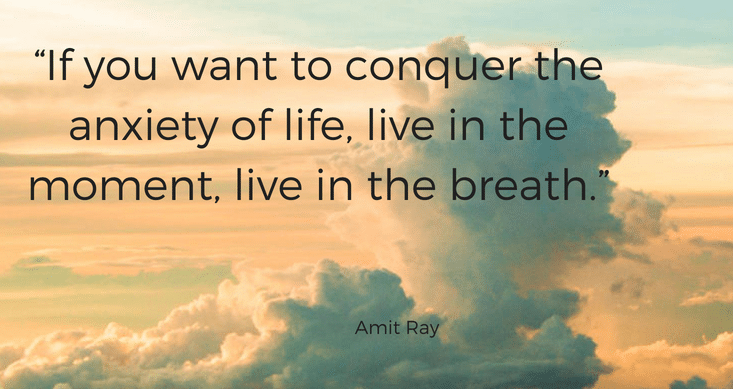
Focus is one of the most important aspects of meditation, and yet it is one of the biggest challenges with which many people struggle.
It doesn’t matter how long you’ve been practicing meditation, focus — and how to maintain it — is always going to be a key element that determines the success you have with your practice.
In this post, I’ll outline 5 easy techniques you can use to develop a strong sense of focus throughout your meditation.
What To Focus On When Meditating: 5 Techniques
Observe The Flow of Your Breath
The first point is also one of the most common. You’ve probably already heard about using the breath as a point of focus during meditation, but the question here is how you focus on your breath.
“Just breathe,” or “Observe your breath,” are common instructions, but what, exactly, does it mean? In my view, there are two main options.
The first is to pay attention to the flow of your breath. From this perspective, you’re noticing the cycle, the motion, of the air as it moves in and out of your body.
Do not over-complicate this idea.
As you breathe in, simply notice that your breath is moving into your body. As you breathe out, simply notice that your breathe is moving out of your body. There’s a really great recording that helps you internalize this idea in our introductory meditation course.
If it helps, you can think those ideas as you’re breathing. Silently say to yourself: Now, I am breathing in. Now, I am breathing out.
After you feel comfortable with this basic technique, you can expand your concentration on how the air is flowing. You can notice how it fills your chest and torso, and, as it does, the energy in your body rises. Then notice how it feels to empty that air, and that energy, on the exhale.

Create a Single Point of Focus
The second technique you can use to concentrate on your breath is to develop a single point of focus.
This practice is one of the core aspects of Vipassana meditation, during which you focus all of your attention on the nostril. The idea is that by narrowing your focus to the point at which your breathe enters and leaves the body, you can enter into a deeper state of concentration.
If you have never used this technique before, it may feel strange the first few times you practice it. I encourage you to try out this technique several times before you decide whether or not you think it is effective and appropriate for you.
While centering on the nostril is a common practice, it isn’t the only place you can focus. Internally, many people like to focus on the rise and fall of their diaphragm.
Any of your seven chakra points can be great places to focus.
You can also use external points to focus on, and create a soft gaze. This is the case for practice like Trataka meditation, during which you stare softly at a flickering candle.
Use Visual Imagery
Another great technique you can use to center your focus during your meditation is to use visual imagery.
By far the most common form of imagery to use is light. Many people like to cultivate the idea of a ball of light entering their body.
You may wish to move this light around your body, focusing briefly on different areas. For example, you could move light through each of your chakra centers, or you could focus light on any area where you feel physical pain or discomfort.
Another option is to use the light as a metaphor for expansion and contraction, and attempt to see this light expanding throughout your body, and then proceeding to expand beyond it, growing your auric field.
If the idea of visualizing light isn’t appealing, you might also use other imagery. You could create a specific place you go to during your meditation. Perhaps when you begin, you imagine walking down a flight of stairs into your meditation room, or open a door into an idyllic field.
It doesn’t matter too much what you visualize, the point of the techniques is to realize that concentrating on imagery will help your mind to focus, giving you a deeper meditation.
Repeat a Mantra or Affirmation
Another very common practice is to repeat a mantra or an affirmation during your meditation.
Mantras are short phrases you repeat silently or aloud. The idea is that as you repeat the mantra, your mind is able to relax more deeply, and the rhythm of the repetition lulls you into a deeper state.

This can be done with a wide variety of affirmations. Patanjali, a guru famous for teaching yogic sutras, believed that any idea could lead to enlightenment. It is not the phrase that matters, it is the act of consistently concentrating on it.
That said, you might be interested in a list of common mantras to get you started.
Listen To a Guided Recording
Lastly, don’t underestimate the power of a good guided recording. There are a wide variety of styles out there for you to choose from, and we talk about the importance of using these recordings — and how to choose them — more in our beginner’s course.
In brief: guided recordings help you to focus, because they captivate the mind and draw you along in the narration. When done well, this can lull you into a Theta state.
I encourage you to experiment with different teachers and narrators. You will naturally be drawn to some more than others, and this is a very personal choice, so keep in mind that what works for one person may not be the same for another.
If You Can’t Concentrate, Relax and Have Fun
While learning to focus during your meditation is important, a lot of times we place too much pressure on ourselves to always be concentrating on a specific idea or goal.
Sometimes, the idea that we “should” be more focused or “not thinking” in our meditations obscures the real goal, and stops us from actually having a deeper experience.
No matter how experienced you are, remember that you will always have ups and downs, on days and off days.
Remember this, and go easy on yourself. If you can’t concentrate, you might take a break, and try again later. Or, simply relax, be patient, and don’t forget to have fun.
To learn more about meditation and to deepen your practice, check out our current list of available courses.



